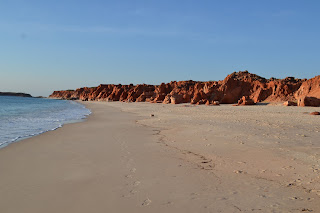From Broome, once again laden with supplies, we set out for the Dampier Peninsular, and in particular Cape Leveque. The cape is at the top of the peninsular, and is reached by 200km of road. The road to Cape Leveque is the stuff of legend. The first 100km of this is rough corrugated sand, shaped in some sections like a skate ramp. As you drive along you can feel your will to live drain away as bits fall off your car. I can't imagine what it must be like for the people who live in these parts and need to use this road each time the need to do a fortnightly trip to woolies or buy some new sheets for the bed. Then, suddenly, the rough sand gives was to smooth, speedy, merciful bitumen. And then one wonders, why this bitumen here? The answer, we subsequently discovered, is to link all of the communities on the peninsular with an all-weather airstrip so people can be evacuated in the wet season if required. Once you have completed the journey you are treated to a spectacular coast line of deep red cliffs, white sandy beaches, crystal clear water, and reefs.
We camped in a beach shelter in red sand. Our days were spent swimming, snorkelling, fishing and lazing in the hammock. Our evenings were sent under the starry sky, listening to the waves and the bugs, roasting marshmallows on a campfire, as the Cape Leveque light house shone out above us.
 |
| Hugo and Zoe spent hours collecting and sorting beautiful shells from the beach |
The indigenous Bardi people of the region are charming and welcoming. A highlight of our visit was a tag along tour with Brian, a Bardi elder and 5 of his assorted kids, nieces and nephews. It was a great opportunity to learn some more about the culture of the local people, as well as a great opportunity for Hugo and Zoe to hang out with some local kids. We went fishing and Zoe caught her first ever fish, whilst Hugo tackled some mud crabs.
The mozzies and sandflies in this part of the world are vicious. We went through a whole can of tropical strength aeroguard in the 5 days we were there, with Hugo still sporting some major scratching wounds.
Perhaps it was DEET toxicity, but we went a bit feral in Cape Leveque. We were dirty, there was sand in the bed, the children were collecting more and more freckles, we didn't exercise or eat enough greens. But we didn't really care. Landing back in Broome in a cramped caravan site, listening to the neighbour's TV blaring "The Voice", flight noise and banging bin lids, we were all a bit cranky. We are now heading to the next instalment in the journey, in Derby poised to tackle the Gibb River Road starting tomorrow.
Notable wildlife sightings: huge bats, turtles, grasshoppers the size of cigars, a mangrove golden whistler, sting rays, clown fish



















































